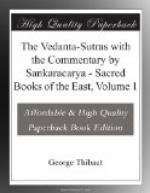the divinity, and the Brahma/n/a, runs against a post,
falls into a pit[205], &c. &c., therefore one must
know all those matters for each mantra’ (Arsheya
Brahma/n/a, first section).—Moreover, religious
duty is enjoined and its opposite is forbidden, in
order that the animate beings may obtain pleasure
and escape pain. Desire and aversion have for
their objects pleasure and pain, known either from
experience or from Scripture, and do not aim at anything
of a different nature. As therefore each new
creation is (nothing but) the result of the religious
merit and demerit (of the animated beings of the preceding
creation), it is produced with a nature resembling
that of the preceding creation. Thus Sm/ri/ti
also declares, ’To whatever actions certain
of these (animated beings) had turned in a former
creation, to the same they turn when created again
and again. Whether those actions were harmful
or harmless, gentle or cruel, right or wrong, true
or untrue, influenced by them they proceed; hence
a certain person delights in actions of a certain
kind.’—Moreover, this world when being
dissolved (in a mahapralaya) is dissolved to that
extent only that the potentiality (sakti) of
the world remains, and (when it is produced again)
it is produced from the root of that potentiality;
otherwise we should have to admit an effect without
a cause. Nor have we the right to assume potentialities
of different kind (for the different periods of the
world). Hence, although the series of worlds
from the earth upwards, and the series of different
classes of animate beings such as gods, animals, and
men, and the different conditions based on caste,
a/s/rama, religious duty and fruit (of works), although
all these we say are again and again interrupted and
thereupon produced anew; we yet have to understand
that they are, in the beginningless sa/m/sara, subject
to a certain determinateness analogous to the determinateness
governing the connexion between the senses and their
objects. For it is impossible to imagine that
the relation of senses and sense-objects should be
a different one in different creations, so that, for
instance, in some new creation a sixth sense and a
corresponding sixth sense-object should manifest themselves.
As, therefore, the phenomenal world is the same in
all kalpas and as the Lords are able to continue their
previous forms of existence, there manifest themselves,
in each new creation, individuals bearing the same
names and forms as the individuals of the preceding
creations, and, owing to this equality of names and
forms, the admitted periodical renovations of the
world in the form of general pralayas and general
creations do not conflict with the authoritativeness
of the word of the Veda. The permanent identity
of names and forms is declared in Sruti as
well as Sm/ri/ti; compare, for instance, Rik.
Sa/m/h. X, 190, 3, ’As formerly the creator
ordered sun and moon, and the sky, and the air, and
the heavenly world;’ which passage means that




